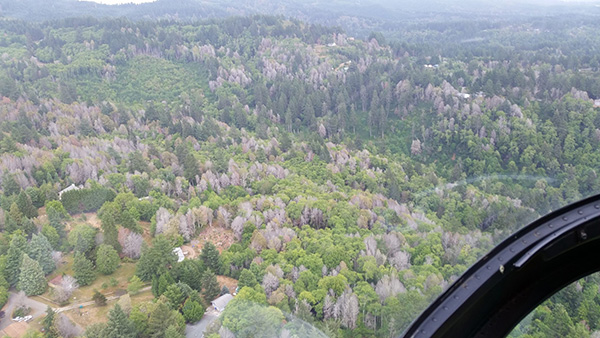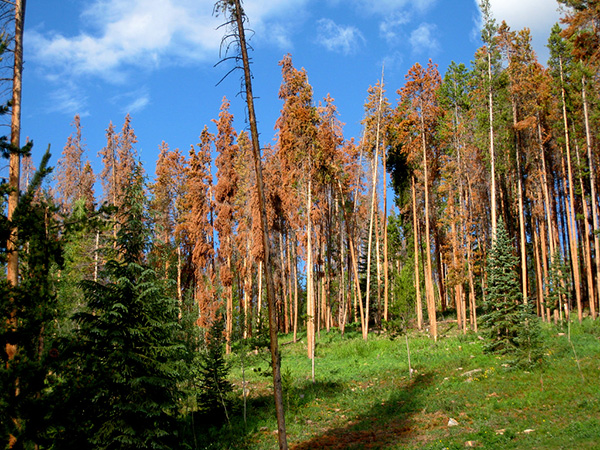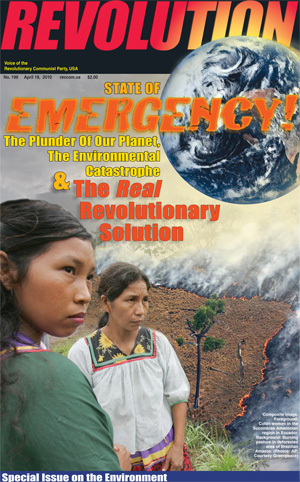Wildfires, Dead Forests, Climate Change… and the Need to Act
December 9, 2017 | Revolution Newspaper | revcom.us
Huge wildfires are burning in Southern California. As of Thursday, December 7, the fires are raging and are out of control. More than 200,000 people have been forced to evacuate their homes. The two largest fires, in Ventura and Los Angeles counties, have burned more than 116,000 acres. More than 300 structures have been destroyed. The 101 and 405 freeways, two of the most congested in the area, were closed as flames and smoke danced onto the highways.
These fires are happening just weeks after huge wildfires swept through Northern California for three weeks in October. The damage was horrific. Forty-two people died. More than 250 square miles burned and 8,400 structures were destroyed.
The destruction caused by the California fires has focused attention on a disturbing pattern: the number and intensity of wildfires is rapidly increasing. According to the Union of Concerned Scientists, wildfires in the western United States have been increasing in frequency and duration since the mid-1980s, occurring nearly four times more often, burning more than six times the land area, and lasting almost five times as long.
While wildfires are a natural part of the forest environment, the increase in number and intensity is being driven in large part by human-caused climate change, along with other factors such as increased construction in the urban-wildland interface and unscientific land management policies. The New York Times reported that researchers found that climate change was responsible for more than half of the dryness of western forests since 1979. Parched landscapes increase fire size and duration.
The increase in wildfires is a global phenomenon. In just June and July of 2017, more than 10,000 people had to flee fires in southern France, more than 60 people were killed in Portugal, nine people died and 10,000 people were evacuated in South Africa and 40,000 people have had to flee wildfires in western Canada.
Today the fire season in the western U.S. stretches, on average, 78 days longer than in the mid-1980s. Higher summer temperatures result in earlier snowmelt. Western forests typically become combustible within a month of when snowmelt is complete. Snowpack melts one to four weeks earlier than it did 50 years ago. In their book Tipping Point for Planet Earth: How Close Are We to the Edge? Anthony Barnosky and Elizabeth Hadly write, “No longer [in California] is there a ‘fire season’ and an off-season. Fires have become a year-round phenomenon. Wildfires, once recognized as local phenomena mostly controlled by precipitation, are a new global ‘normal,’ mostly controlled by temperature.”
Another factor behind the fires in California has been an increase in strong, dry winds. These are called Diablo winds in Northern California and Santa Ana winds in Southern California. During the wine country fires there were winds of up to 80 miles per hour and winds of similar force are spreading the wildfires in Ventura and Los Angeles counties.
Dying Forests Part 1: Sudden Oak Death

Sudden Oak Death responsible for dead tanoak trees in Oregon. (Credit: Oregon Department of Forestry)
A dramatic increase in the tree-killing disease known as Sudden Oak Death (SOD) helped spread the massive Northern California fires. Living oak trees are relatively resistant to fire. Dead and dying oak trees make wildfires hotter and cause them to spread more quickly. Matteo Garbelotto, the director of the UC Berkeley Forest Pathology and Mycology Laboratory, sampled trees in the Sonoma area prior to the fires and found that 37 percent were infected by SOD, a ten-fold increase compared with two years ago.
SOD is widespread in the coastal regions of Central and Northern California and southern Oregon. Millions of trees have died as a result of the disease.
While it did not bring the SOD pathogen to the United States, climate change has likely played a role in the spread of the disease. Scientists from the U.S. Department of Agriculture say that climate change is conducive to the spread of SOD, which spreads in warm and wet environments. “Increased temperature and moisture scenarios increased the likelihood of P. ramorum infection in California,” they write.
(Climate change comes about through a complex interaction of many different factors, and global warming has different effects on the climate in different regions. In some areas it can lead to warmer and dryer temperatures and in others warmer and wetter. Other areas could become cooler even as the overall average temperature of the Earth increases.)
A study by Ross Meentemeyer of North Carolina State University and others found that “in the absence of extensive control, we predict a ten-fold increase in [SOD] disease spread between 2010 and 2030 with most infection concentrated along the north coast between San Francisco and Oregon.”
Dying Forests Part 2: Pine Bark Beetle

Lodgepole pines killed by the pine bark beetle.
(Credit: V Smoothe/Creative Commons)
The explosive population growth of the pine bark beetle is also destroying forests. Pine bark beetles inhabit ponderosa, whitebark, lodgepole, Scotch, jack pine, and limber pine trees in the western U.S. and Canada. These insects play an important role in the life of a forest, attacking old or weakened trees, and speeding development of a younger forest, according to badbeetle.com.
Prior to about 1990, winter temperatures were low enough to kill off a large number of the beetles each year. The beetles and the trees were in relative ecological equilibrium. As winter temperatures have risen, the beetle population has increased exponentially.
The pine bark beetle has killed billions of trees, likely the largest forest insect outbreak ever recorded, nearly 10 times the size of past eruptions. “A doubling would have been remarkable,” entomologist Diana Six told Mother Jones. “Ten times screams that something is really going wrong.”
In their book, Barnosky and Hadly describe the effect: “What used to be tens of millions of acres of mature green forest when we were growing up and when our kids were born are now dead sticks reaching for the sky, from New Mexico all the way up the Rocky Mountain chain through Canada and into Alaska. That’s why as you drive through that part of the world, in places you will find that 60 to 80 percent of the trees are dead. All that death happened in the course of a decade.”
“We’re talking millions of trees killed, whole mountain sides dying,” Dr. David Rizzo of UC Davis told the Guardian newspaper. A recent aerial survey by the U.S. Forest Service tallied 36 million more dead trees in California between May and November 2016.
The devastation of forests has been most marked in the West, but all forests in this country are in danger. “Our analysis shows virtually all U.S. forests are now experiencing change and are vulnerable to future declines,” forest researchers from Duke University wrote. “Given the high degree of uncertainty in our understanding of how forest species and stands adapt to rapid change, it’s going to be difficult to anticipate the type of forests that will be here in 20 to 40 years.”
Beyond Repair

This Revolution special issue focuses on the environmental emergency that now faces humanity and Earth’s ecosystems.
Read the section "Some Key Principles of Socialist Sustainable Development"
Read the entire issue online....
Also available in brochure format (downloadable PDF)
“There’s virtually nothing you can do to stop the beetles, either, unless they’ve killed everything and run out of food. Or unless the climate cools, and I don’t think anyone’s expecting that anytime soon.”
—Diana Six, entomologist, University of Montana
While it is not the only factor involved in the increase in wildfires and the spread of forest pathogens, climate change is transforming and harming the Earth in ways that CANNOT be repaired.
Forests play a crucial role in the environment. They provide clean water, lock up carbon (the main cause of climate change) and shelter whole ecosystems. Devastated forests leave birds, mammals and other living things that rely on them without food, shelter or the means for survival. The destruction of forest areas contributes to what is called a negative feedback loop, where increased temperatures and other climate changes kill trees and forests, which, because the trees no longer lock up carbon, increases global warming, leading to more dying trees, and on and on.
The Need to Act
In the face of all of this and many other manifestations of climate change, Trump and his regime are actively sabotaging any attempts to deal with this. They are attacking climate change science and working to destroy the infrastructure that scientists and the government have built up over years to study and monitor changes in climate; they are censoring scientists; and they are doing what they can to unleash more burning of fossil fuels, which accelerates climate change.
One of humanity’s goals should be to protect the precious resources of our planet and to leave it in better shape for future generations. The Earth’s forests, and much else, have already been damaged in ways that cannot be reversed. We must act NOW, with the urgency that the situation demands, to stop Trump and Co. from destroying the planet.
Volunteers Needed... for revcom.us and Revolution
If you like this article, subscribe, donate to and sustain Revolution newspaper.

